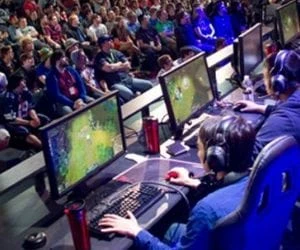eSports market update: DFS boost – market breakdown

The esports vertical is booming, but controversy also surrounds it, says Peter Warman of Newzoo, who also provides demographic breakdown, main regions for action and audiences and what to expect from the vertical.
2015 was another huge year for eSports, with the industry garnering an increasing amount of attention from press, publishers, broadcasters, investors and advertisers alike.
But how do the demographics break down, which regions provide most of the action and audiences and what more can we expect from the vertical?
Global esports revenues totalled US$325m last year and will reach over US$463m in 2016, according to Newzoo’s 2016 Global Esports Market Report.
This represents an impressive year-on-year growth of 43%. This revenue includes online advertising, brand partnerships, media rights, merchandise and tickets and additional game publisher investments into the industry.
These estimates exclude revenue made from betting and fantasy drafting, as this does not flow directly into eSports channels. In fact, it is highly likely that betting revenues alone will exceed the US$1bn mark before esports revenues do.
eSports enthusiasts: a valuable target group
The eSports audience will also continue to rise, with the number of eSports enthusiasts expected to reach 131 million this year. Occasional viewers, who tune in mainly for the big international events, will total 125 million people across the globe.
While the demographic of traditional sports keeps rising, eSports entertains a young and desirable demographic. At the same time, the average age of all eSports enthusiasts and occasional viewers is higher than some may expect, with 47% of enthusiasts aged between 21 and 35 (see Figure 1 below).

Figure 1: eSports age/gender profiles
The crowd that visits live events skews significantly younger but is not representative of the total audience. The majority of the audience has a full-time job and a higher average income, representing a very valuable target group that is willing to spend money.
In terms of betting, 35% of enthusiasts in the US already bet or wager on real-time events such as sports a few times a week and 33% regularly play for real money in online casinos.
The rise of betting, fantasy sports and controversy
Mainstream attention to esports has triggered a surge in new esports betting and fantasy league companies, as well as investments in these companies.
Established online bookmakers such as Sky Bet, William Hill, Dafabet, Pinnacle, Bet365, ESP and Betway are among the operators hoping to tap into this new revenue stream, while dedicated betting and fantasy eSports sites such as Unikrn, AlphaDraft and Vulcun have also emerged.
Betting volumes in China have been rumored to be more than US$100m on a single championship event.
The rise of eSports betting benefits tournaments in two ways: the increased engagement it offers to viewers and to sponsorships. Viewers are more likely to watch a game to the end or a smaller league game if they have money riding on it. Betting companies have also provided funding through sponsorships to various teams, personalities and leagues.
The emergence of eSports betting has not come without its fair share of problems however. Notably, the possible encouragement of match fixing or underage betting among the younger eSports audience.
Following the arrest of 12 South Koreans accused of fixing Starcraft 2 games in October 2015, Unikrn announced their initiative for a Code of Conduct designed to reduce instances of match fixing and other cheating scandals.
Similarly, In October 2015, ESL announced their partnership with Sportradar to, among other objectives, monitor match fixing, collusion and other activities related to illegal, underage and irresponsible betting.
US leads eSports revenues, Asia fuels audience growth
In 2016, North America will strengthen its lead in terms of revenues, with an anticipated US$175m generated through merchandise, event tickets, sponsorships, online advertising and media rights.
A significant part of these revenues flows back to the game publisher, but across all publishers, more money is invested into the eSports economy than is directly recouped by their eSports activities.
China and Korea together will represent 23% of global eSports revenues, totaling US$106m in 2016. Audience-wise, the situation is different, with Asia contributing 44% of global eSports enthusiasts. Growth in this region is, for a large part, fueled by an explosive uptake in Southeast Asia (see Figure 2).

Figure 2: eSports audience growth
Key trends driving growth
From a trend perspective, this year has been dominated by the amount of investors getting involved in eSports.
An increasing amount of traditional media companies have become aware of the value of the eSports sphere and have launched their first eSports initiatives. With these parties getting involved, there will be an increased focus on content and media rights.
All major publishers have increased their investment into the space, realising that convergence of video, live events and the game itself are providing consumers the cross-screen entertainment they desire from their favorite franchises.
The role that mobile screens play in this is crucial. We believe the uptake of mobile games as eSports will accelerate in 2016, particularly in Asia, as many start-ups intensify their efforts and global mobile players get involved. Supercell’s most recent title, Clash Royale, is the ultimate example.
Peter Warman is CEO and co-founder of Newzoo.
